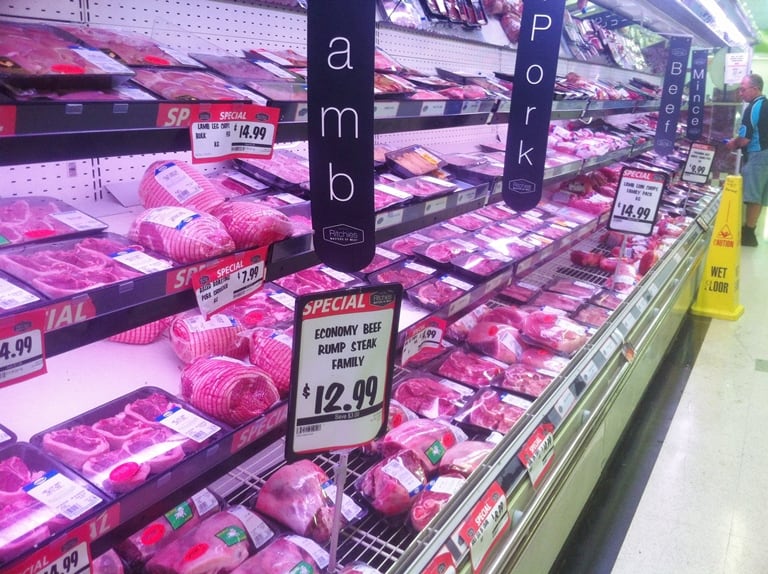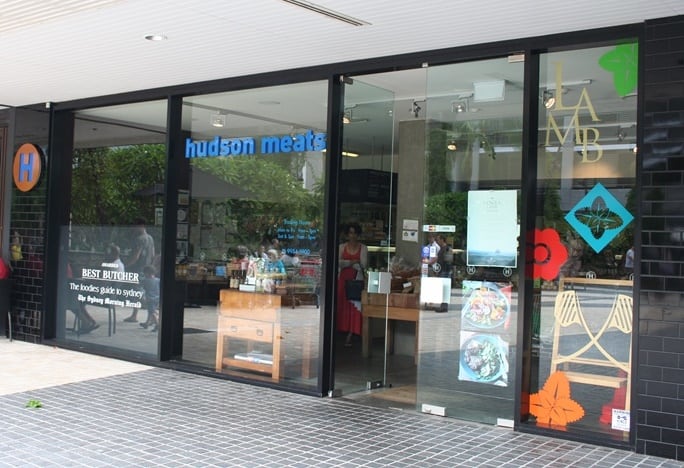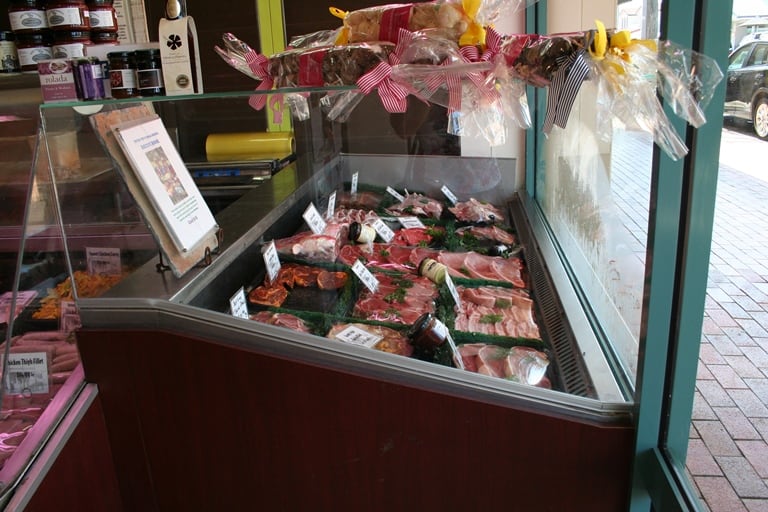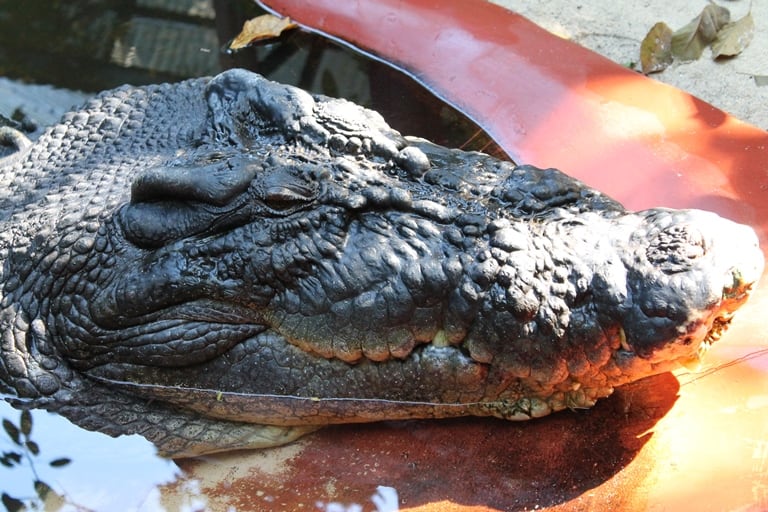This is nearly three times the global average of 42.2kg per capita/year and slightly higher than countries with similar demographics and culinary traditions, such as the US, Canada and the UK.
Statistics from Australian organisations are slightly more conservative. Australian Chicken Meat Federation figures place average annual per head consumption at 115kg, with chicken the most consumed meat (45kg/capita/year) followed by beef and veal (33.6kg/capita/year), pork (26.6kg/capita/year) and then lamb and mutton (9.8kg/capita/year).
This represents a major shift from 65 years ago, when beef and lamb were the principal meats consumed in Australia and chicken and pork made up a very small proportion of total per capita consumption.

Price has clearly played a part, as have increasing concerns about dietary health and low-fat proteins, according to Andrea Dubs, executive director of the Australian Chicken Meat Federation: "Historically, the price of a fresh whole chicken has remained stable in terms of dollars of the day. So essentially, over recent years, chicken meat has become more affordable approximately by the rate of the general CPI [inflation] increase.
"We believe that the past reduction in real price combined with cost increases due to higher-welfare requirements, including free range, is likely to lead to a moderate increase in the price over coming years. Nevertheless, chicken will remain by far the most affordable meat protein available that is low in fat," he tells GlobalMeatNews.
The shift to meats other than beef and lamb can also be explained in part by the intense and prolonged migration to Australia from all parts of the world. As of June 2014, 28% of Australia’s 23.5 million population were born overseas, according to the Australian Bureau of Statistics, with around 40% of families having at least one member born overseas in the 2011 census.
Although the largest numbers of overseas-born citizens still hail from the UK and New Zealand, there has been significant migration from Asia to Australia, notably from China and India, and the influence of Asian cultures on the Australian food landscape has been profound. Asian ingredients are commonplace in Australian supermarkets, even in rural areas, and ethnic cuisines are a common feature in Australian restaurants.

The average Australian spends about AU$70 (US$53.90) per person a week (amounting to a total national spend of AU$60 billion/US$46.2bn a year) on eating out in cafés, takeaway outlets and restaurants, according to a 2013 report by the Commonwealth Bank of Australia. The report identified the top three choices of takeaway food as Chinese, Italian and Thai, three cuisines that make extensive use of pork, chicken and seafood, as well as beef.
The great majority of fresh meat consumed in Australia is domestically raised and slaughtered. Mince remains the most popular form of retail beef, followed by non-prime steaks and sausages, according to Meat and Livestock Australia (MLA), while according to Australian Pork Limited, the most popular pork cuts are boneless, rindless and trimmed of as much fat as possible. While indigenous wild animals, such as kangaroos and crocodiles, are harvested and their meat is readily available, consumption is limited. Around 6,000 tonnes (t) of kangaroo meat is produced for domestic human consumption and 40t of crocodile meat a year, according to Food Standards Australia New Zealand figures.
Australia’s food retail sector is dominated by the presence of two major supermarket chains, Woolworths (owned by publicly listed Australian company Woolworths Ltd) and Coles (owned by one of Australia’s largest listed companies Wesfarmers Ltd). Together, the two supermarket chains account for an estimated 80% of market share, according to the Master Grocers Australia association of independent retailers, with a buying power that makes it tough for small businesses to compete. The apparent duopoly of these two retail giants has been the cause of several investigations and legal proceedings by the Australian Competition and Consumer Commission (ACCC).
The most recent figures available from MLA show that red meat retail deviates slightly from this trend, allowing a slightly larger space for independent retailers and competitors than is the case for the general grocery sector. According to MLA’s 2012 Red Meat Market Report, Coles and Woolworths combined take 56% of beef sales and 62% of lamb sales, while butchers and speciality stores accounted for 24% and 27% respectively.

The Independent Grocers of Australia (IGA), a chain of 1,400 independently owned local grocery stores, also provides some competition, accounting for 9% of beef retail sales and 7% of lamb. German discount supermarket chain Aldi is a relative newcomer in Australia; it opened its first store in the country in 2001 and now has about 300 stores across the eastern states. Aldi is gradually increasing its market share and accounts for 6% of beef sales and 3% of lamb.
Despite the convenience of buying meat in a supermarket, and the fact that most large supermarkets have in-house butchers, independent ‘local shop’ butchers are still popular with Australian consumers, particularly for higher-quality, value-added products. Independent butchers are keen to promote themselves as fresh meat specialists, and industry bodies such as the Australian Meat Industry Council and the Australian Butchers’ Guild conduct frequent marketing campaigns to sustain this image.
A local butcher in the northern New South Wales (NSW) town of Lennox Head, Trevor Brown, says that some consumers would always prefer the butcher. "You have supermarket people who are attracted to the convenience where you can buy everything in one place, including meat, and then butchery people who will always choose the butcher," he said. Brown, who provides a range of gourmet products and pre-prepared cuts, says his business has doubled in value over 10 years, and that he is very pleased about its progress, especially given it is "hard to compete on price with the supermarkets".

The rise of so-called ‘gourmet’ and organic food products in Australia over the past decade has been significant, carving out new spaces for food businesses. One grocery chain called Harris Farm Markets, for example, has expanded from a single fruit and vegetable shop in Western Sydney in 1971 to a chain of 25 stores across Sydney and regional NSW and a successful online and wholesale business. The stores carry a range of well-priced quality fruit and vegetables, oils and condiments as well as the Belmore range of organic meats, prime cuts of red meats, poultry and processed meats.
The supermarket giants have tried to boost their own image as purveyors of quality produce, with aggressive marketing campaigns. Woolworths, with its enduring brand slogan, ‘the fresh food people’, recruited international chef Jamie Oliver and produced a ‘Created with Jamie’ range that includes several pre-prepared meat dishes requiring little cooking. Coles has similarly used local celebrity chef Curtis Stone in its advertising and even renowned chef Heston Blumenthal, who has released a ‘Heston for Coles’ range, including fresh sausages and pre-cooked gourmet meat products.
Supply of fresh red meat is set to be an issue for both big supermarkets and local butchers alike this year. Australia experienced the largest turn-off on record of its national herd in 2014, thanks mainly to a crippling drought that affected almost all cattle-producing areas of the country. As conditions improve, numbers will slowly recover, but MLA projections forecast a 14.4% drop in beef production and a 5.9% decline in kg/capita consumption of beef in 2015.
The consequential rising red meat prices and declining per capita consumption will almost certainly play to the advantage of chicken meat sales, with strong growth forecast in this sector – particularly in free range and pre-prepared options – according to Dubs. "Free range will continue to make up an increasing proportion of chicken meat sales, however organic will remain a niche market estimated to be less than half of 1% of the total chicken meat market in Australia. The variety of ready-to-cook pre-prepared chicken dishes will continue on an upward trend and most product sold frozen will be further processed, as is already the case now," he says.
